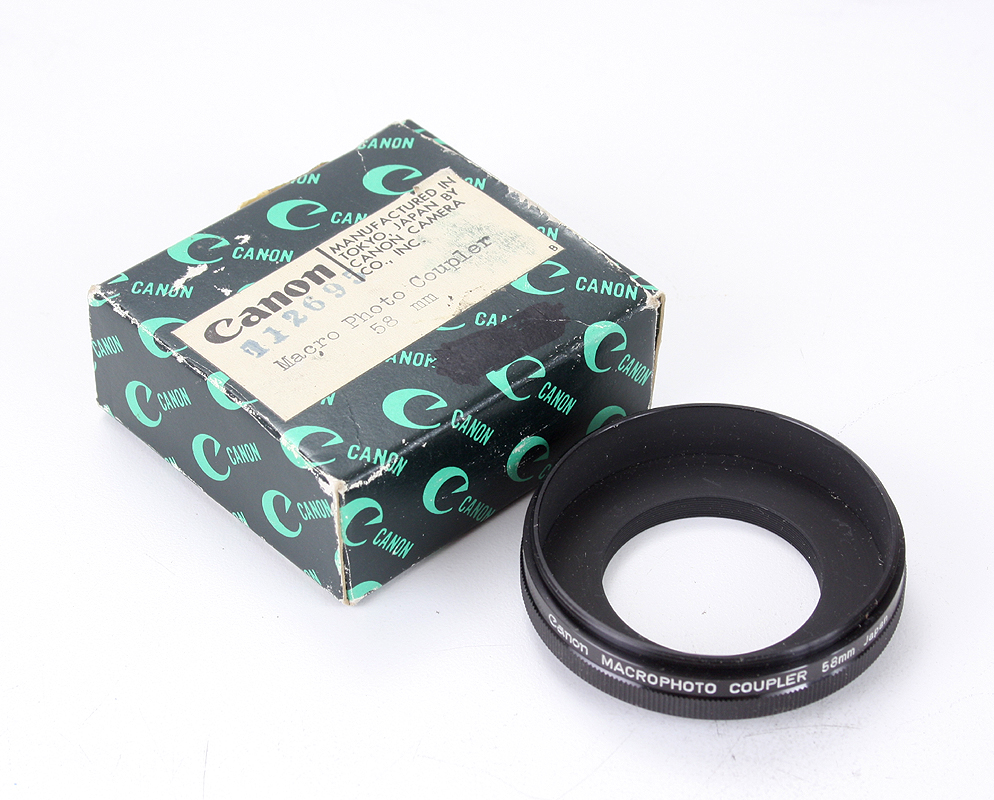
Photographica Pages
An online guide to collectable cameras and related stuff
Canon Canonflex Close-up
Accessories
On the one hand, close-up photography is very simple. The lens needs to be at a certain distance to
focus it to infinity. Move it further away from the film
and the focal point becomes closer to the camera. Most lenses are limited in their ability to focus close
by the length of their focus helical There are three
common ways to focus closer than the shortest distance your lens will focus.
The simplest is an extension tube. It really is nothing more than a tube, or set of tubes that go between
the camera and lens to move it further away. Usually
they are sold in a set of various lengths that can be assembled into a variety of lengths, the distance
between them can be made up with the focus on the lens.
They are simple and inexpensive, but a bit cumbersome in use.
Another method of moving the lens further away is a bellows unit. Mounted on a track, it usually gives a
longer extension than most extension tube sets, and is
infinitly and continuously variable in length. However they tend to be more expensive, and are limited to
how far away they can focus, as the minimum extension
might be closer than the lens alone would focus, leaving a gap between the minimum focus distance of
the lens, and the maximum focus distance with the bellows.
This is due to the thickness of the bellows unit completely compressed.
Finally, close-up lenses can be screwed onto the front of the lens like a filter. These are the simplest to
use, but are a generally bit more expensive than
extension tubes, and may degrade the image a little. However, they are compact to carry and easy to
use.
The Bellows R was available for the Canonflex with Canon R mounts at both ends. In July 1963 (all of
the prices on this page will be from that price list) was
$55.00, with case.If you wanted to mount a screw mount lens to the end of the bellows instead of a
Canon R lens, you used the Lens Mount Converter A, which was
$11.50
The extension tubes were a little more complicated. The tubes themselves were common to both the R
and rangefinder systems, being in 39mm Leica thread mount.
You threaded them into Lens Mount Converter A. If you were using a Leica thread mount lens, you
would thread that directly into the tube (Leica thread had
become the standard for enlarging lenses as Leitz pioneered 35mm, nd enlarging lenses were
designed to be flat field corrected, which was helpful in copying).
The Extension Tube Set consisted of tubes A (6mm), B (9mm and C (12mm), and was $7.00. The
individual tubes were $2.35, $2.50 and $2.75 respectively each.
There were also longer individual tubes of 25mm ($3.50), 50mm ($4.50), 75mm ($5.95), 100mm
($7.50), 150mm ($9.95) and 200mm ($12.50) which could be purchased
as a set for $43.90.
If you wanted to mount a Canonflex mount lens to the tube, you just added Lens Mount Converter B to
the end. It was $6.50.
Another option for use with both the bellows and extension tubes was a ring to mount the lens in
reverse. For some close-up applications this was adventageous.
This required the Macrophoto Coupler 58. This threaded into a 58mm filter ring on a lens, and had a
male Leica thread on the other end, which would thread
directly into the extensionb tube, or could be threaded into the Lens Mount Converter A (although on
mine, I could not get it to mount without putting and
extension tube between them as the Coupler wouldn't clear the lip on the Converter). The Macrophoto
Coupler 58 sold for $4.95. In addition they offered the
Photomicrographic Hood, which was a lens hood that bayoneted into the lens mount when the lens was
reversed, for $7.50.
Finally, Canon offered two different close-up lenses in 58mm thread. The Close-Up Lens 450 gave
focusing distances of 55-33cm with the 50/1.8 Super Canomatic,
the Close-Up Lens 240 gave 33-26cm. They were $16.50 each.
It should be noted that much of the macro equipment was carried into the FL era, and even into the FD
system. In some instances the only way to identify it's vintage is if it has the original packaging.

The Canon Bellows R, with box. In this iteration it was sold without the case (the box has cardboard
inserts that preclude a case being included).

The Canon Bellows R, mounted on a body with normal 50/1.8 Super Canomatic R.

The same, but the lens reversed using the Macrophoto Coupler 58, an extension tube and Lens Mount
Converter A.

The Macrophoto Coupler 58, with box.

The 50/1.8 Super Canomatic R mounted on a camera using the extension tube set (A, B and C) and
Lens Mount Converter A.

The same, but the lens reversed using the Macrophoto Coupler 58, extension tube set (A, B and C)
and Lens Mount Converter A.

The Canon Bellows R, with box. In this iteration it was sold without the case (the box has cardboard inserts that preclude a case being included).

The Canon Bellows R, mounted on a body with normal 50/1.8 Super Canomatic R.

The same, but the lens reversed using the Macrophoto Coupler 58, an extension tube and Lens Mount
Converter A.

The Macrophoto Coupler 58, with box.

The 50/1.8 Super Canomatic R mounted on a camera using the extension tube set (A, B and C) and
Lens Mount Converter A.

The same, but the lens reversed using the Macrophoto Coupler 58, extension tube set (A, B and C)
and Lens Mount Converter A.
